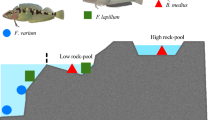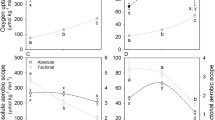Abstract
Oxygen demand generally increases in ectotherms as temperature rises in order to sustain oxidative phosphorylation by mitochondria. The thermal plasticity of ectotherm metabolism, such as that of fishes, dictates a species survival and is of importance to understand within an era of warming climates. Within this study the whole animal O2 consumption rate of a common New Zealand intertidal triplefin fish, Forsterygion lapillum, was investigated at different acclimation temperatures (15, 18, 21, 24 or 25 °C) as a commonly used indicator of metabolic performance. In addition, the mitochondria within permeabilised skeletal muscle fibres of fish acclimated to a moderate temperature (18 °C Cool acclimation group—CA) and a warm temperature (24 °C. Warm acclimation group—WA) were also tested at 18, 24 and 25 °C in different states of coupling and with different substrates. These two levels of analysis were carried out to test whether any peak in whole animal metabolism reflected the respiratory performance of mitochondria from skeletal muscle representing the bulk of metabolic tissue. While standard metabolic rate (SMR- an indicator of total maintenance metabolism) and maximal metabolic rate (\(\dot{M}\)O2 max) both generally increased with temperature, aerobic metabolic scope (AMS) was maximal at 24 °C, giving the impression that whole animal (metabolic) performance was optimised at a surprisingly high temperature. Mitochondrial oxygen flux also increased with increasing assay temperature but WA fish showed a lowered response to temperature in high flux states, such as those of oxidative phosphorylation and in chemically uncoupled states of respiration. The thermal stability of mitochondria from WA fish was also noticeably greater than CA fish at 25 °C. However, the predicted contribution of respirational flux to ATP synthesis remained the same in both groups and WA fish showed higher anaerobic activity as a result of high muscle lactate loads in both rested and exhausted states. CA fish had a comparably lower level of resting lactate and took 30 % longer to fatigue than WA fish. Despite some apparent acclimation capacity of skeletal muscle mitochondria, the ATP synthesis capacity of this species is constrained at high temperatures, and that a greater fraction of metabolism in skeletal muscle appears to be supported anaerobically at higher temperatures. The AMS peak at 24 °C does not therefore represent utilisation efficiency of oxygen but, rather, the temperature where scope for oxygen flow is greatest.





Similar content being viewed by others
References
Bouchard P, Guderley H (2003) Time course of the response of mitochondria from oxidative muscle during thermal acclimation of rainbow trout, Oncorhynchus mykiss. J Exp Biol 206:3455–3465
Brand MD (1990) The contribution of the leak of protons across the mitochondrial inner membrane to standard metabolic rate. J Theor Biol 145:267–286
Brand MD (2005) The efficiency and plasticity of mitochondrial energy transduction. Biochem Soc Trans 33:897–904
Brown GC (1999) Nitric oxide and mitochondrial respiration. Biochim Biophys Acta 1411:351–369
Clark TD, Jeffries KM, Hinch SG, Farrell AP (2011) Exceptional aerobic scope and cardiovascular performance of pink salmon (Oncorhynchus gorbuscha) may underlie resilience in a warming climate. J Exp Biol 214:3074–3081
Clark TD, Sandblom E, Jutfelt F (2013) Aerobic scope measurements of fishes in an era of climate change: respirometry, relevance and recommendations. J Exp Biol 216:2771–2782
Condon CH, Chenoweth SF, Wilson RS (2010) Zebrafish take their cue from temperature but not photoperiod for the seasonal plasticity of thermal performance. J Exp Biol 213:3705–3709
Dupont-Prinet A, Vagner M, Chabot D, Audet C (2013) Impact of hypoxia on the metabolism of Greenland halibut (Reinhardtius hippoglossoides). Can J Fisheries Aquat Sci 70:461–469
Farrell AP (2002) Cardiorespiratory performance in salmonids during exercise at high temperature: insights into cardiovascular design limitations in fishes. Comp Biochem Physiol 132A:797–810
Franklin CE, Farrell AP, Altimiras J, Axelsson M (2013) Thermal dependence of cardiac function in arctic fish: implications of a warming world. J Exp Biol 216:4251–4255
Fry FEG (1971) The effect on environmental factors on the physiology of fish. In: Hoar WS, Randall DJ (eds) Fish physiology, 4th edn. Academic Press, New York, pp 1–98
Galli GLJ, Richards JG (2012) The effect of temperature onmitochondrial respirationin permeabilized cardiac fibres from the fresh water turtle, Trachemys scripta. J Therm Biol 37:195–200
Gnaiger E (2008) Mitochondrial pathways through complexes I + II: convergent electron transport at the Q-junction and additive effect of substrate combinations. In: Gnaiger E (ed) Mitochondrial pathways and respiratory control, 2nd edn. MiPNet Publications, Innsbruck, pp 21–37
Gnaiger E (2011) Mitochondrial pathways through Complexes I + II: convergent electron transport at the Q-junction and additive effect of substrate combinations. Oroboros Instruments, Mitochondrial Physiology Network
Guderley H, St-Pierre J (2002) Going with the flow or life in the fast lane: contrasting mitochondrial responses to thermal change. J Exp Biol 205:2237–2249
Hammill E, Wilson RS, Johnston IA (2004) Sustained swimming performance and muscle structure are altered by thermal acclimation in male mosquitofish. J Therm Biol 29:251–257
Healy TM, Schulte PM (2012) Thermal acclimation is not necessary to maintain a wide thermal breadth of aerobic scope in the common killifish (Fundulus heteroclitus). Physiol Biochem Zool 85:107–119
Hickey AJ, Clements KD (2003) Key metabolic enzymes and muscle structure in triplefin fishes (Tripterygiidae): a phylogenetic comparison. J Comp Physiol B 173:113–123
Hilton Z, Clements K, Hickey A (2010) Temperature sensitivity of cardiac mitochondria in intertidal and subtidal triplefin fishes. J Comp Physiol B 180:1–12
Iftikar FI, Hickey AJR (2013) Do mitochondria limit hot fish hearts? Understanding the role of mitochondrial function with heat stress in Notolabrus celidotus. PLoS ONE 8:e64120
Iftikar FI, MacDonald J, Hickey AJR (2010) Thermal limits of portunid crab heart mitochondria: Could more thermo-stable mitochondria advantage invasive species? J Exp Mar Biol Ecol 395:232–239
Iftikar FI, MacDonald JR, Baker DW, Renshaw GMC, Hickey AJR (2014a) Could thermal sensitivity of mitochondria determine species distributions in a changing climate? J Exp Biol 217:2348–2357
Iftikar FI, MacDonald JR, Baker DW, Renshaw GMC, Hickey AJR (2014) Could thermal sensitivity of mitochondria determine species distributions in a changing climate? J Exp Biol (in press)
Johnston I, Lucking M (1978) Temperature induced variation in the distribution of different types of muscle fibre in the goldfish (Carassius auratus). J Comp Physiol 124:111–116
Khan JR, Herbert NA (2012) The behavioural thermal preference of the common triplefin (Forsterygion lapillum) tracks aerobic scope optima at the upper thermal limit of its distribution. J Therm Biol 37:118–124
Newsholme EA, Crabtree B (1986) Maximum catalytic activity of some key enzymes in provision of physiological useful information about metabolic fluxes. J Exp Zool 239: 159–163
Parks RE, Adler J, Copenhaver JH (1955) The efficiency of oxidative phosphorylation in mitochondria from diabetic rats. J Biol Chem 214:693–698
Pesta D, Gnaiger E (2012) High-resolution respirometry: OXPHOS protocols for human cells and permeabilized fibers from small biopsies of human muscle. In: Palmeira CM, Moreno AJ (eds) Mitochondrial bioenergetics. Humana Press, New York, pp 25–58
Picard M, Taivassalo T, Gouspillou G, Hepple RT (2011) Mitochondria: isolation, structure and function. J Physiol
Pörtner HO (2002) Climate variations and the physiological basis of temperature dependent biogeography: systemic to molecular hierarchy of thermal tolerance in animals. Comp Biochem Physiol 132A:739–761
Pörtner HO, Knust R (2007) Climate change affects marine fishes through the oxygen limitation of thermal tolerance. Science 315
Pörtner HO, Mark FC, Bock C (2004) Oxygen limited thermal tolerance in fish? Answers obtained by nuclear magnetic resonance techniques. Resp Physiol Neurobiol 141:243–260
Reidy SP, Nelson JA, Tang Y, Kerr SR (1995) Post-exercise metabolic rate in Atlantic cod and its dependence upon the method of exhaustion. J Fish Biol 477:377–386
Richter A, Kolmes SA (2005) Maximum temperature limits for chinook, coho, and chum salmon, and steelhead trout in the Pacific northwest. Rev Fisheries Sci 13:23–49
Seebacher F, Brand MD, Else PL, Guderley H, Hulbert AJ, Moyes CD (2010) Plasticity of oxidative metabolism in variable climates: molecular mechanisms. Physiol Biochem Zool 83:721–732
St-Pierre J, Charest PM, Guderley H (1998) Relative contribution of quantitative and qualitative changes in mitochondria to metabolic compensation during seasonal acclimatisation of rainbow trout Oncorhynchus mykiss. J Exp Biol 201:2961–2970
Veksler VI, Kuznetsov AV, Sharov VG, Kapelko VI, Saks VA (1987) Mitochondrial respiratory parameters in cardiac tissue: a novel method of assessment by using saponin-skinned fibers. Biochim Biophys Acta 892:191–196
Wilson RS, Condon CHL, Johnston IA (2007) Consequences of thermal acclimation for the mating behaviour and swimming performance of female mosquito fish. Philos Trans R Soc B 362:2131–2139
Zukiene R, Nauciene Z, Ciapaite J, Mildaziene V (2010) Acute temperature resistance threshold in heart mitochondria: febrile temperature activates function but exceeding it collapses the membrane barrier. Int J Hyperthermia 26:56–66
Author information
Authors and Affiliations
Corresponding author
Additional information
Communicated by I. D. Hume.
Rights and permissions
About this article
Cite this article
Khan, J.R., Iftikar, F.I., Herbert, N.A. et al. Thermal plasticity of skeletal muscle mitochondrial activity and whole animal respiration in a common intertidal triplefin fish, Forsterygion lapillum (Family: Tripterygiidae). J Comp Physiol B 184, 991–1001 (2014). https://doi.org/10.1007/s00360-014-0861-9
Received:
Revised:
Accepted:
Published:
Issue Date:
DOI: https://doi.org/10.1007/s00360-014-0861-9




